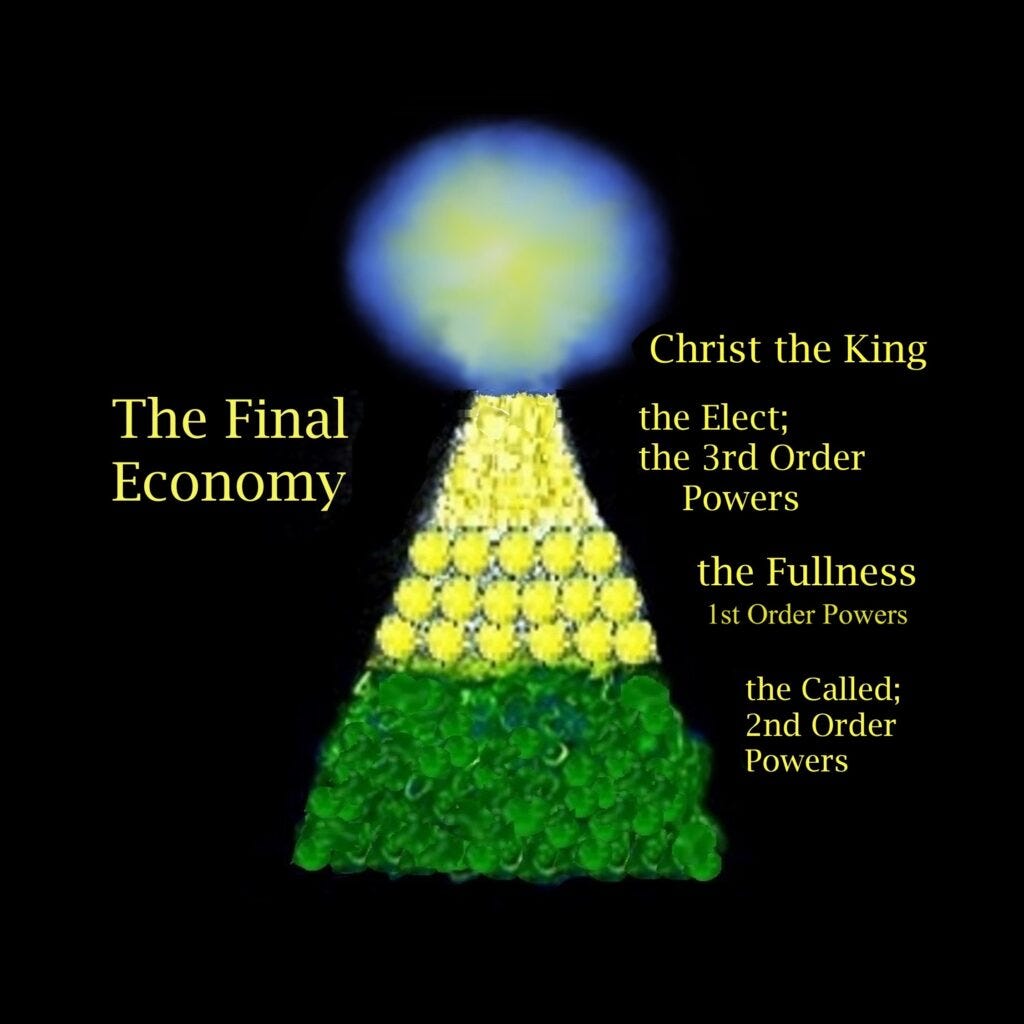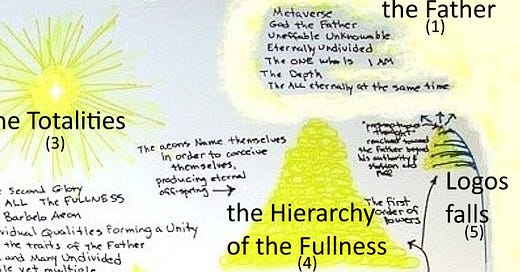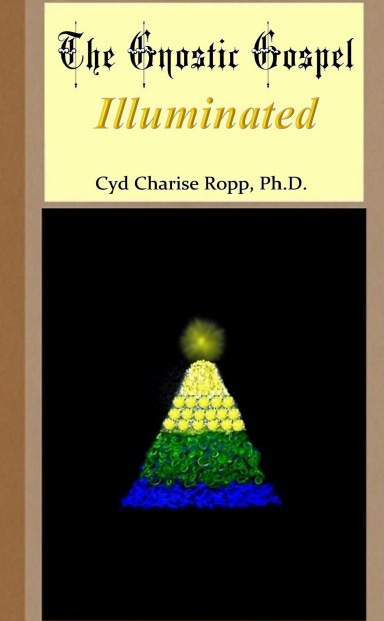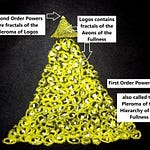Ten years ago, back in July 22nd of 2015, I wrote one of my first articles about Gnosticism on my Simple Explanation blog, and I'm going to read from that for you today. This was very soon after I began to realize that the Orthodox Christianity that I had been strongly embracing for all of my life could be enhanced by this knowledge of Gnosticism.
I had been trained up to believe that Gnosticism was a heresy, and it takes many years for a very strong believer in Christianity to even be willing to consider Gnosticism as another sect of Christianity. So while not being willing to give up my belief in the Christ as our salvation, and not being willing to demote my relationship with Jesus, because I can't deny that since I personally know it to be true, I was at last able to begin reading the Nag Hammadi texts. I was particularly taken by the text called the Tripartite Tractate, which is the one that I share with you mostly on this Gnostic Insights podcast.
So let me share with you now this first article that I wrote in 2015 called Yearning for the Pleroma, which is still posted on my long-running Simple Explanation blog. This was originally broadcasted as an episode in August of 2021, which was before I started posting episodes to Substack, so my Substack readers have never seen or heard this episode. Also, for those of you who have been following Gnostic Insights from the beginning, you haven’t ever had a chance to read the transcript, so here it is. As I said, this article is ten years old. I hadn’t yet developed the illustrations that have become so familiar by now, which you can see throughout the Gnostic Insights transcripts and in The Gnostic Gospel Illuminated book from 2019. This episode features my first attempt at diagramming the gnostic cosmology. The concepts still hold up, although the artwork is more colorful and polished today.
This is called Yearning for the Pleroma.
Other words for the Gnostic word "pleroma" include the "Fullness," the "All," the "Totalities," and "the circle of divine attributes," which gives you a pretty good idea of what pleroma means. The way wikipedia defines the term is much more challenging and kind of discouraging because of its complexity, especially the section on Gnosticism. Wikipedia cites 17 uses of the Greek word kenoma that is usually translated as “fullness,” with only one usage of pleroma as we Gnostics would define it.
Only one book of the Bible mentions the Pleroma--a letter written to the church in Colosse by the apostle Paul. In the translation of Colossians 2:9 below, Pleroma has been rendered as "the fullness."
"For in Him [Christ] dwells all the fullness of the Godhead bodily; and you are complete in Him, who is the head of all principality and power" (Col. 2:9).
The footnote under this verse in my edition of the New King James Version goes on to completely misinterpret the meaning of the statement in its rush to dismiss the Gnostic implications of the verse. The Nelson editors contend that "the Gnostics thought the fullness of God had been divided among a number of angelic beings, the last creating the material world. In contrast, Paul says that the fullness of God exists in Christ... This contradicts the Gnostic idea of the inherent evil of physical bodies and the claim that Jesus is merely a spirit (p. 2014, Nelson Study Bible. 1997).
While I do agree with the opening premise that "the Gnostics thought the fullness of God had been divided among a number of ... beings," there are at least four misrepresentations I see in the Nelson explanation of the verse.
First, the idea that the fullness can't be both completely in Christ and at the same time divided into aeons. No need to say, "In contrast," since the two traits are not mutually exclusive. Let's imagine how that would work.
Here are the first four phases of Gnostic Cosmology, according to the Tripartite Tractate. Upper right corner: God the Father represented as the background paper of the entire poster. Upper left corner: I've represented the Son as a diffuse cloud of will. Middle: the Pleroma/the fullness represented as the Son's cloud with distinct lines representing the aeonic traits. The pyramid to the right represents the individual aeons after they have named themselves and differentiated the Son's will into hierarchies of traits and powers.
We begin with the Father, since this is the ground state underlying all else. We all know that the Father is unknowable. Too big, too exalted for us mere mortals to contemplate directly. The Father is the Immortal One who never changes and without whom nothing would exist. The indisputable buck-stops-here God. This being is pure consciousness, without form or distinctions, all quiet, eternally undivided. This is the One Who Is; the Great I Am. In my drawings, the Father is represented as the paper that makes up the poster--all other manifestations arise as images upon the paper and are fully contained by the paper.
The Son is represented by the starburst cloud at the upper left, although the starburst is not really light energy, since this is before the creation of Light. This entity is also called the First Aeon, the Root, the Single Name, and The Form of the Formless. The Son contains all of the qualities of the Father, but in a circumscribed form. In today's lingo we would call the Son a holographic representation of the Father, where a small fragment perfectly emulates the larger image. You could think of the Father as the ocean, and the Son as a big bucket of ocean water. It's the same fluid. And if the bucket remains immersed in the ocean, then not only is the water within and without the bucket identical, the ocean continues to fully contain the bucket of water.
The Tripartite Tractate describes how the Son is part of the Father, and then goes on in the same verse to declare the Son as the cause of the Pleroma:
"He exists by the Father having him as a thought--that is, his thought about himself, his sensation of himself and of his eternal being... He possesses power, which is his will. For the moment, however, he holds himself back in silence, he who is the greatest, being the cause of the generation of the members of the All into eternal existence" (Tripartite Tractate, verse 56).
By this one verse we can see that the Son is within the Father and he also contains the Fullness, in full agreement with Colossians 2:9.
My second problem with the Nelson notes is their description of aeons. Aeons are not the same as angels--they're more like features or capabilities. The Tripartite Tractate describes them as "the properties and qualities in which the Father and the Son exist" and equates them with the pre-existent Church (Tripartite Tractate, verse 58).
"His offspring, the ones who are, are without number and limit and at the same time indivisible. They have issued from him, the Son and the Father... The Church exists in the dispositions and properties in which the Father and the Son exist... Therefore it subsists in the procreations of innumerable aeons" (Tripartite Tractate, verse 59).
While some Aeons are beings with their own self-aware personalities, other aeons are best described as traits and capabilities of the Father and Son.
"...they were unable to know the depth in which they were; nor was it possible for them to know themselves, nor for them to know anything else. That is, they were with the Father; they did not exist for themselves. Rather, they only had existence in the manner of a seed... like a fetus... not yet come into being" (Tripartite Tractate, verse 60).
Third, the Nelson Study Bible footnote confuses Jesus, the physical incarnation of Christ on Earth, with the eternal spirit of Christ, the first Son of the Father, whose image and dwelling predates the Earthly appearance of Jesus.
"Now the Savior in fact was a bodily image of something unitary, namely the Fullness" (Tripartite Tractate, verse 116).
The Gnostic gospel I've been studying has no quibble with naming the physical person of Jesus Christ as the Lord and Savior of the entire Creation. Lest the wary Christian doubt the Gnostic's gospel, the Tripartite Tractate ends with this eulogy for Jesus Christ:
"...the praise, the power, and the glory, through Jesus Christ, the Lord, the Savior, the Redeemer of all those who are embraced by the mercy of love, and through his Holy Spirit, from now throughout all generations forever and ever. Amen" (Tripartite Tractate, verse 138).
And finally, the Nelson editor contends "the fullness of God [that] exists in Christ" ... "contradicts the Gnostic idea of the inherent evil of physical bodies." The editor apparently reasons that if Gnostics claim physical bodies are evil, and Jesus incarnated as a physical body, then Gnosticism would imply that Jesus Christ was evil.
There are a couple of problems with this logic. First, my reading of Gnostic writing reveals that while material reality may have started out as "evil," the situation was quickly rectified when the Son and the Pleroma intervened to establish an "economy" that regulated good and evil inclinations through "repentance." Keep in mind that material reality can be considered demiurgic, but not “evil” per se. Nothing is “evil,” only misguided by egoic striving. Here's a brief description of that process:
"After conversion followed the remembrance of those who exist and the prayer on behalf of the one who had returned to himself by means of what is good" (81).... "This prayer and supplication helped to make him turn toward himself and toward the Fullness, for their remembrance of him caused him to remember the preexistent ones, and this is the remembrance that calls out from afar and brings him back" (Tripartite Tractate, verse 82).
"To those who belong to the remembrance, however, he revealed the thought ... with the intention that it should draw them into a communion with the material. This was in order to provide them with a structure and a dwelling place, but also in order that by being drawn toward evil they should acquire a weak basis for their existence, so that, instead of rejoicing unduly in the glory of their own environment and thereby remaining exiled, they might rather perceive the sickness they were suffering from, and so acquire a consistent longing and seeking after the one who is able to heal them from this weakness" (Tripartite Tractate, verse 98, 99).
"The first human, then, is a mixed molding and a mixed creation, and a depository of those on the left and those on the right, as well as of a spiritual Word, and his sentiments are divided between each of the two substances to which he owes his existence" (Tripartite Tractate, verse 106).
"What our Savior became, out of willing compassion, is the same as that which the ones for whose sake he appeared had become because of an involuntary passion: they had become flesh and soul, and this holds them perpetually in its grip, and they perish and die... For not only did he assume their death for the ones he had in mind to save, but in addition he also assumed their smallness, to which they had descended when they were born with body and soul; for he let himself be conceived and he let himself be born as a child with body and soul" (Tripartite Tractate, verse 114, 115).
Secondly, the very fact that Jesus did incarnate as a mortal man is what made salvation through Christ possible, for it was by the Savior's perfect "error correcting algorithm," superimposed upon an otherwise error-filled humanity, that salvation entered the world.
I'll end this article with a clear gospel message straight from the Tripartite Tractate regarding exactly what one must come to believe in order to be saved.
"... there is no other baptism apart from this one alone, which is the redemption into God, Father, Son, and Holy Spirit, when confession is made through faith in those names, which are a single name of the gospel, when they have come to believe what has been said to them, namely that they exist. From this they have their salvation, those who have believed that they exist. This is attaining in an invisible way to the Father, Son, and Holy Spirit in an undoubting faith" (Tripartite Tractate, verse, 127, 128).
That seems to be the underlying core of the Gnostic salvation message. No other arcane rituals are needed; no gnosis other than believing that the Father, Son, and Holy Spirit (the Fullness) existed before you. Other ancient gnostic texts claim that this is the true essence of the gospel that Jesus preached.
Keep in mind that these are the very texts considered so distracting by the early church Fathers that they were buried in the Egyptian desert in the 4th century AD to protect them from being burned as the work of heretics, keeping them safe until their reemergence in 1945. The cat is definitely out of the bag now.
Okay, back to the Pleroma. In case you haven't guessed, the Fullness is where we all wind up eventually. By the end of the universe, everyone's souls will have come on board Team God, so to speak, and then the fruit of the Pleroma will have returned home to the fold, to live happily ever after amidst the unending joy and love of the Fullness, all tucked up inside the Son who lives inside the Father.

"Once the redemption had been proclaimed, the perfect human [the Savior] immediately received knowledge so as to return swiftly to his unity, to the place from which he came. Joyfully he returned back to the place from which he had originated, the place from which he had flowed forth. His limbs, however, needed a school... until all the limbs of the body of the Church would be united in one place and would attain the restoration together... so that the Fullness obtains its redemption" (Tripartite Tractate, verses 123, 124).
So, that is the end of this article that I wrote several years ago, and ever since writing this article, I have been more fully developing this Gnostic Gospel until it emerged as my own book called The Gnostic Gospel Illuminated, which is, in my own words, meant to be simple and understandable. No quotes, it's not academic, it's the straightforward Gnostic Gospel, and it's fully illustrated so that each illustration shows you what, in my mind, these things look like. But they're metaphors, they're only visual metaphors, but they should help you to grasp this information. Sometimes the words are difficult, but I find it much easier to grasp the information when it is presented in a visual form. So please go ahead and visit my GnosticInsights.com website, where you can click on and purchase The Gnostic Gospel Illuminated book. I've printed it as a larger picture kind of book, in that 6x9 format, glossy pictures and all. Very pretty. But I've also printed it as a small pocket edition that you could actually put in your back pocket of your jeans, which harkens back to my old days as a young Christian, as a one-way Christian in the late 1960s, when I used to carry my little pocket edition of the Good News Bible in my back pocket. So I encourage you to get that book and read it, and read it several times, many times, until it soaks in, until you get how easy redemption is.
And this Gnostic Gospel does not attempt to dethrone Jesus Christ. It dethrones a false god called the Demiurge, which does appear here and there throughout the Bible, but it does not dethrone the Father of the Christ, which is the God Above all gods.
Well, thank you for joining me this week. I hope you've enjoyed this review of Yearning for the Pleroma, and that you've gained some clarity concerning what the Pleroma, or the fullness of God, means. Remember, our Father is a God of clarity, and knowledge, and thinking. You should never come away from Gnostic studies lost in confusion. Many of the podcasts I hear that call themselves Gnostic are being narrated by people who are themselves confused about the nature of the Father and gnosis, in my opinion. If you come away feeling confused, then it's not the clarity that we try to achieve here at Gnostic Insights and in the Gnostic Reformation on Substack. Our God is not the God of confusion. That would be the job of the Demiurge. Until next week, onward and upward, and God bless us all.














Share this post